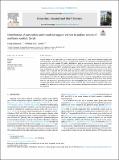Files in this item
Distribution of particulate and dissolved organic carbon in surface waters of northern Scottish fjords
Item metadata
| dc.contributor.author | Smeaton, Craig | |
| dc.contributor.author | Austin, William E.N. | |
| dc.date.accessioned | 2022-06-20T13:30:04Z | |
| dc.date.available | 2022-06-20T13:30:04Z | |
| dc.date.issued | 2022-09-05 | |
| dc.identifier | 280131615 | |
| dc.identifier | b52d67d9-98e6-43e5-bdd4-b22994075d46 | |
| dc.identifier | 85132701025 | |
| dc.identifier | 000822802400001 | |
| dc.identifier.citation | Smeaton , C & Austin , W E N 2022 , ' Distribution of particulate and dissolved organic carbon in surface waters of northern Scottish fjords ' , Estuarine, Coastal and Shelf Science , vol. 274 , 107952 . https://doi.org/10.1016/j.ecss.2022.107952 | en |
| dc.identifier.issn | 0272-7714 | |
| dc.identifier.other | RIS: urn:A59A9C6DA158CD651EF2C05534D5152C | |
| dc.identifier.other | ORCID: /0000-0003-4535-2555/work/114977302 | |
| dc.identifier.uri | https://hdl.handle.net/10023/25550 | |
| dc.description | This project was supported by the Scottish Blue Carbon Forum. | en |
| dc.description.abstract | Coastal waters can act concurrently as a source and sink of carbon (C), with coastal sediments trapping and storing significant quantities of C, while C is simultaneously released to the atmosphere through biogeochemical processes in the water column. The mid-to high-latitudes fjords are recognised as hotspots for the burial and storage of OC in their sediments and for their potential to provide a long-term climate regulation service. Yet the distribution of particulate (POC) and dissolved organic carbon (DOC) in fjord water columns remains a significant knowledge gap, that is particularly acute in temperate vegetated systems such as those in the North Atlantic. Here we present POC and DOC data from surface waters across four Scottish fjords with differing meteorological, catchment and submarine geomorphological characteristics to both quantify and understand the factors governing the spatial distribution of POC and DOC in fjords. The measured POC and DOC concentrations in the surface waters of the four fjords are broadly analogous to other temperate vegetated fjord systems around the world. Within these systems, local factors such as submarine geomorphology is the primary factor driving POC and DOC dispersal in fjord surface waters. The data highlights that fjords are important pathways for the transport and storage of POC and DOC in the coastal ocean and that a greater focus is required on the water column OC to allow the role fjords play in near- (water column) and long-term (sediment) climate regulation to be quantified. | |
| dc.format.extent | 6 | |
| dc.format.extent | 4454174 | |
| dc.language.iso | eng | |
| dc.relation.ispartof | Estuarine, Coastal and Shelf Science | en |
| dc.subject | Carbon | en |
| dc.subject | Fjords | en |
| dc.subject | Dissolved organic carbon | en |
| dc.subject | Particulate organic carbon | en |
| dc.subject | Mid-latitude | en |
| dc.subject | Surface water | en |
| dc.subject | G Geography (General) | en |
| dc.subject | DAS | en |
| dc.subject.lcc | G1 | en |
| dc.title | Distribution of particulate and dissolved organic carbon in surface waters of northern Scottish fjords | en |
| dc.type | Journal article | en |
| dc.contributor.institution | University of St Andrews. Environmental Change Research Group | en |
| dc.contributor.institution | University of St Andrews. School of Geography & Sustainable Development | en |
| dc.contributor.institution | University of St Andrews. Scottish Oceans Institute | en |
| dc.contributor.institution | University of St Andrews. St Andrews Sustainability Institute | en |
| dc.contributor.institution | University of St Andrews. Coastal Resources Management Group | en |
| dc.contributor.institution | University of St Andrews. Marine Alliance for Science & Technology Scotland | en |
| dc.identifier.doi | https://doi.org/10.1016/j.ecss.2022.107952 | |
| dc.description.status | Peer reviewed | en |
This item appears in the following Collection(s)
Items in the St Andrews Research Repository are protected by copyright, with all rights reserved, unless otherwise indicated.

